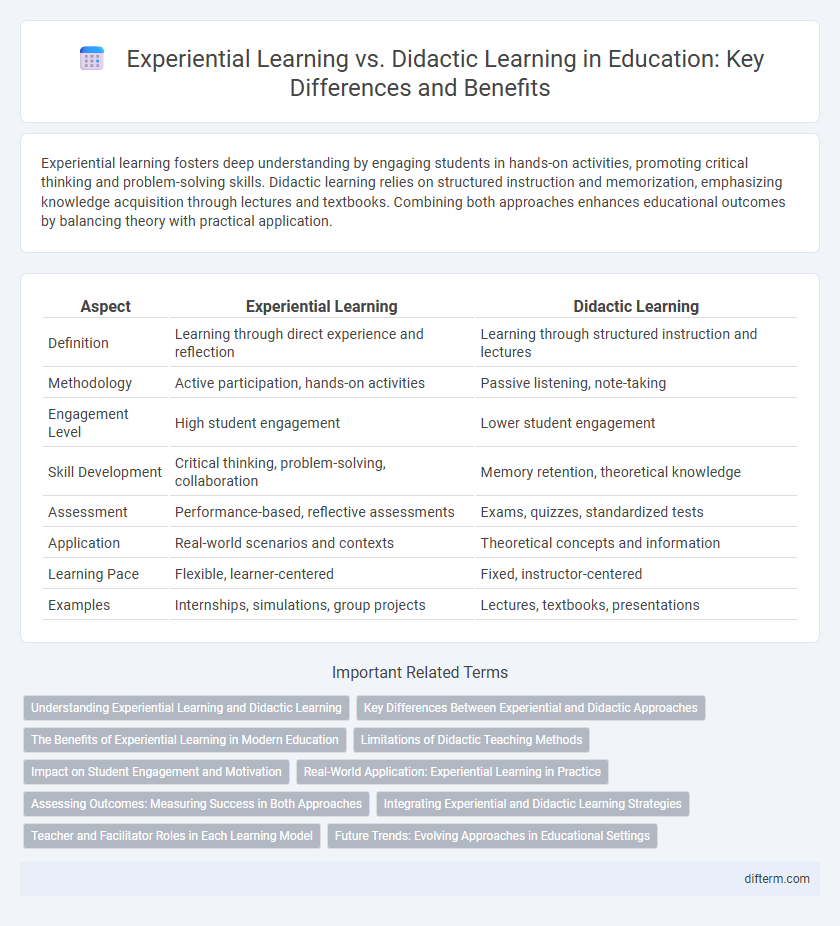Experiential learning fosters deep understanding by engaging students in hands-on activities, promoting critical thinking and problem-solving skills. Didactic learning relies on structured instruction and memorization, emphasizing knowledge acquisition through lectures and textbooks. Combining both approaches enhances educational outcomes by balancing theory with practical application.
Table of Comparison
| Aspect | Experiential Learning | Didactic Learning |
|---|---|---|
| Definition | Learning through direct experience and reflection | Learning through structured instruction and lectures |
| Methodology | Active participation, hands-on activities | Passive listening, note-taking |
| Engagement Level | High student engagement | Lower student engagement |
| Skill Development | Critical thinking, problem-solving, collaboration | Memory retention, theoretical knowledge |
| Assessment | Performance-based, reflective assessments | Exams, quizzes, standardized tests |
| Application | Real-world scenarios and contexts | Theoretical concepts and information |
| Learning Pace | Flexible, learner-centered | Fixed, instructor-centered |
| Examples | Internships, simulations, group projects | Lectures, textbooks, presentations |
Understanding Experiential Learning and Didactic Learning
Experiential learning emphasizes active participation and reflection, enabling learners to internalize knowledge through real-world experiences and problem-solving activities. Didactic learning relies on structured, teacher-centered instruction where information is transmitted systematically through lectures and textbooks. Understanding the distinctions between these approaches highlights how experiential learning fosters critical thinking and practical skills, while didactic methods often prioritize theoretical knowledge and standardized assessment.
Key Differences Between Experiential and Didactic Approaches
Experiential learning emphasizes hands-on, active participation where students engage directly with materials or real-world scenarios, fostering critical thinking and problem-solving skills. Didactic learning relies on structured, teacher-centered instruction focused on memorization and theory delivery, often through lectures or textbooks. The key differences lie in the learner's role--active in experiential methods and passive in didactic approaches--and the nature of knowledge acquisition, which is practical and contextual in experiential versus theoretical and abstract in didactic learning.
The Benefits of Experiential Learning in Modern Education
Experiential learning enhances student engagement by actively involving learners in real-world tasks, promoting deeper understanding and retention compared to traditional didactic methods. It fosters critical thinking, problem-solving, and collaboration skills essential for adapting to dynamic educational and professional environments. Modern education increasingly values experiential learning for its ability to develop practical competencies and self-directed learning habits.
Limitations of Didactic Teaching Methods
Didactic teaching methods often limit student engagement by emphasizing passive knowledge transfer rather than active participation, which can hinder critical thinking and problem-solving skills development. These methods rely heavily on memorization and lecture-based delivery, leading to lower retention and reduced ability to apply concepts in real-world scenarios. Unlike experiential learning, didactic approaches frequently fail to accommodate diverse learning styles and practical skill acquisition essential for effective education.
Impact on Student Engagement and Motivation
Experiential learning significantly enhances student engagement and motivation by actively involving learners in hands-on activities and real-world problem-solving, fostering deeper understanding and retention. In contrast, didactic learning often relies on passive reception of information, which can lead to diminished interest and lower intrinsic motivation. Studies indicate that students participating in experiential learning environments exhibit higher enthusiasm and persistence, resulting in improved academic outcomes and long-term skill development.
Real-World Application: Experiential Learning in Practice
Experiential learning emphasizes real-world application by engaging students in hands-on projects and problem-solving scenarios that mirror actual professional challenges. This approach fosters critical thinking and retention by connecting theoretical knowledge with practical experiences in settings such as internships, simulations, and service learning. Unlike didactic learning, which relies on passive absorption of information, experiential methods develop skills that directly translate to workplace effectiveness and innovation.
Assessing Outcomes: Measuring Success in Both Approaches
Assessing outcomes in experiential learning involves evaluating practical skills, critical thinking, and real-world problem-solving through performance-based assessments and reflective portfolios. Didactic learning outcomes are typically measured by standardized tests, quizzes, and written assignments that focus on knowledge retention and theoretical understanding. Combining both assessment types provides a comprehensive view of student success, integrating cognitive mastery with applied competencies.
Integrating Experiential and Didactic Learning Strategies
Integrating experiential and didactic learning strategies enhances educational outcomes by combining hands-on practice with structured theoretical instruction. Experiential learning fosters critical thinking and problem-solving skills through real-world applications, while didactic learning provides foundational knowledge and systematic content delivery. Blending these methods creates a dynamic learning environment that addresses diverse learning styles and promotes comprehensive understanding.
Teacher and Facilitator Roles in Each Learning Model
In experiential learning, the teacher acts as a facilitator, guiding students through hands-on activities and encouraging reflection to deepen understanding. In contrast, didactic learning positions the teacher as the primary knowledge provider, delivering content through lectures and structured instruction. Facilitators in experiential settings promote student autonomy and critical thinking, while teachers in didactic models emphasize accuracy and mastery of information.
Future Trends: Evolving Approaches in Educational Settings
Experiential learning increasingly integrates technology and real-world problem-solving to foster critical thinking and adaptability, becoming a cornerstone in future educational models. Didactic learning is evolving through personalized and adaptive digital platforms that enhance content delivery and individualized pacing. Educational settings are shifting towards hybrid approaches that blend hands-on experiences with targeted instruction to better prepare students for dynamic career landscapes.
experiential learning vs didactic learning Infographic

 difterm.com
difterm.com